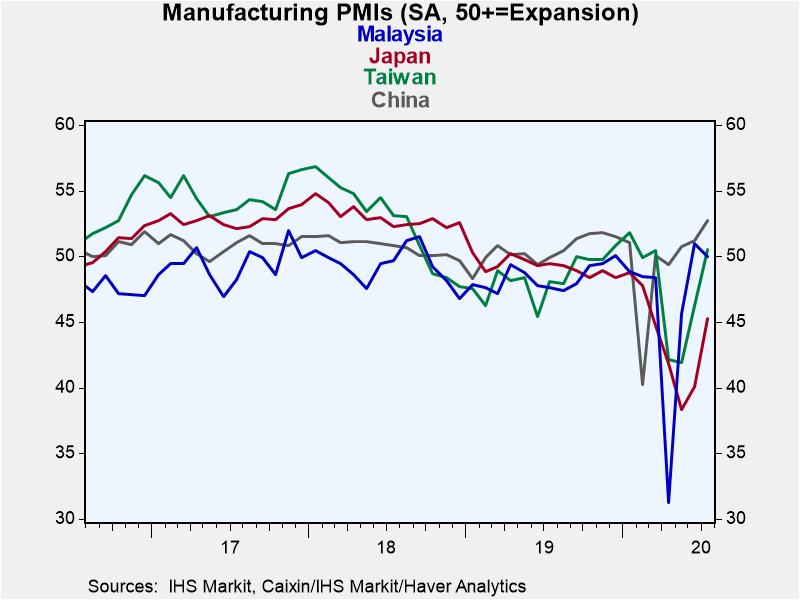 Global| Aug 03 2020
Global| Aug 03 2020MFG PMIs Show Revivals But Not Strength
Summary
Manufacturing largely improved in July and it has been improving in the past few months. But the sector is coming out of a period of extraordinary weakness. So this is more like a patient improving in intensive care after surgery than [...]
 Manufacturing largely improved in July and it has been improving in the past few months. But the sector is coming out of a period of extraordinary weakness. So this is more like a patient improving in intensive care after surgery than like a weightlifter emerging from the gym in better shape. Manufacturing is not flexing its muscle; it is trying to learn to walk again.
Manufacturing largely improved in July and it has been improving in the past few months. But the sector is coming out of a period of extraordinary weakness. So this is more like a patient improving in intensive care after surgery than like a weightlifter emerging from the gym in better shape. Manufacturing is not flexing its muscle; it is trying to learn to walk again.
Of the 16 entities listed in the table, eight are at or below the 50 mark for diffusion. That observation implies that manufacturing is expanding on a relatively broad but still mixed basis. In addition, most readings improved on the month; only four did not. In June, ten entities were below a reading of 50 on diffusion. In May, all but one were below 50 (notably China was the exception). In a few months, manufacturing has responded quite well. For the reporters in the table, the average manufacturing PMI reading has progressed to 49.5 in July from 47.1 in June, 39.4 in May, and a low reading of 35.3 in April when the virus hit the hardest. But even now the average (unweighted) reading is only a few ticks below neutral. The average for Asia alone (unweighted) is slightly worse at 48.2.
The good news is that globally manufacturing in improving. But it is a mixed process and after a somewhat rapid start, it has slowed its pace. The unweighted averages for 12-months, six-months and three-months show the 12-month averages all are weaker than they were 12-months ago. The six-month averages show that all except one (Germany) are weaker than their 12-month averages. But the three-month averages are stronger in ten of the sixteen observations. That’s a good solid ratio of improvement. However, over three months all but China have manufacturing PMI averages below 50.
The queue rankings (right-most column) also tell a story of how recovery is going. These gauges back to January 2016 place Malaysia, Brazil and China at relatively strong readings compared to the whole period while the United Kingdom and France post July readings that are above their medians for that period but are not particularly strong. All other entities (11 of them) have queue standings below their median values since January 2016. Seven have standings still in their lower 10th percentile of that queue of values. China and Brazil are posting the strongest values they have seen since January 2016.
For the most part the manufacturing rankings are moderate to weak. The average for period has improved but is still not impressive. The few countries that log strong queue standings do that mostly because their current reading is being compared to a very weak history. Brazil’s 58.2 diffusion reading in July is an exception. It is authentically high; but China’s highest reading for the period just posted in July at a value of 52.8, a still quite moderate reading despite its high ranking. Malaysia’s strong 83.6 percentile standing also corresponds to a very modest 50.0 diffusion reading in July.
The chart of selected Asian countries from this sample gives a pretty good rendering of what is in train. There was a sharp drop and then a strong spring back in activity. But the drop was stronger than the recovery. And the recovery, while putting several positive responses together, still falls short of a full restoration of pre-covid-19 values and the recent gains show signs of diminishing.
The problem in evaluating the post covid-19 rebound is that there was a sharp spring back, but then countries began to experience reinfections and there have been new lockdowns or other actions that have restrained subsequent activity. A number of countries are facing restrained environments. In the U.S., a number of states are in the same quandary. As a result, it is now impossible to easily handicap the future.
Robert Brusca
AuthorMore in Author Profile »Robert A. Brusca is Chief Economist of Fact and Opinion Economics, a consulting firm he founded in Manhattan. He has been an economist on Wall Street for over 25 years. He has visited central banking and large institutional clients in over 30 countries in his career as an economist. Mr. Brusca was a Divisional Research Chief at the Federal Reserve Bank of NY (Chief of the International Financial markets Division), a Fed Watcher at Irving Trust and Chief Economist at Nikko Securities International. He is widely quoted and appears in various media. Mr. Brusca holds an MA and Ph.D. in economics from Michigan State University and a BA in Economics from the University of Michigan. His research pursues his strong interests in non aligned policy economics as well as international economics. FAO Economics’ research targets investors to assist them in making better investment decisions in stocks, bonds and in a variety of international assets. The company does not manage money and has no conflicts in giving economic advice.






